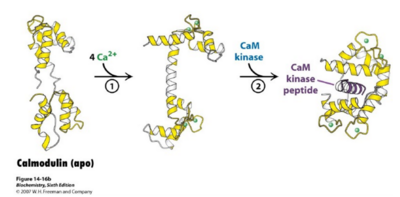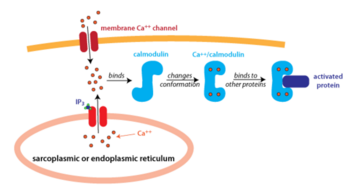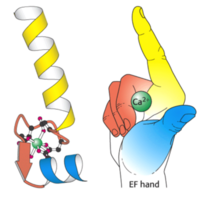Calmodulin JMU
From Proteopedia
|
Contents |
Calmodulin
Calcium is an essential mineral that is needed in the human diet for proper functioning of neurons, for the formation of strong bones, and to act as a second messenger for enzymes and proteins. Calmodulin (CaM), short for calcium modulated protein, is a small calcium binding protein with a three dimensional structure that allows calcium ions to come into the cells. Calmodulin is known to be involved in various Ca2+ - dependent signal transduction pathways, the protein can act as a Ca2+ detector, and the protein is involved with regulating protein-kinases [1].
Its importance can be exemplified by the fact that the protein is known to be highly conserved in eukaryotes. Highly conserved structures that do not undergo significant evolutionary changes imply that the structure is essential for cell or organism survival and that any mutations in the genetic sequence that codes for the protein would be deleterious. The function of calmodulin is typically studied using yeast as a model organism. This is done for a variety of reasons, including the fact that yeast has a fully annotated genome with human homologues for genes associated with their ion channels, yeast is fast growing and yeast are heat stable[2]. Due to its ability to be easily manipulated, yeast can continue to be used to gather more information on calmodulins’ structure and function.

Calmodulin in the body
Calmodulin is located and used ubiquitously by cells, but is especially prevalent in the brain and muscle tissues. It has also been found in human serum, breast milk, urine, and saliva[4]. Calmodulin in the cell is mainly localized within organelles and binds to calcium. Calcium binding then promotes the phosphorylation of protein kinases and activation of other proteins to begin signal transduction for a variety of different pathways, mainly different forms of cell signaling. The phosphorylation of these protein-kinases occurs when Ca2+ reach about 1000 nM and initiates a rapid signaling pathway[5].

Structural Highlights
Calmodulin has a molecular mass of 16 kilodaltons (kD) and it functions along with ryanodine receptor (RyR)[7]. CaM consists of 148 amino acid residues and is characterized by a helix-loop-helix binding motif, also known as the [8]. Calmodulin has one subunit with a distinct dumbbell shape in which a linker region joins two globular domains[9]. Calmodulin is known to undergo a conformational change upon binding with a calcium ion in which each lobe transitions from a closed conformation to an open conformation[10]. This protein has four major, high-affinity binding sites, as shown by figure 1. The calmodulin has been shown to be a series of hydrophobic amino acids (such as Trp or Leu), hydrophilic amino acids (such as Glu or Asp), and basic amino acids (such as Arg or Lys)[11]. Calmodulin typically wraps around its target, with the two globular domains gripping either side of it (Figure 1). NMR studies clearly show that the connector between the two calcium binding globular domains is flexible even when it is not bound to its target proteins. However, the full range of flexibility can be seen in calmodulin interactions with its target proteins (Figure 1).

Function
Each end of the of CaM binds to two calcium ions, which allows CaM to bind to a total of four calcium ions. The binding of calcium to these globular domains initiates a conformational change in the protein, which leads to a cascade effect(Figure 1). Calmodulin elicits a signal transduction pathway by activating protein kinases, which can then go on to phosphorylate other proteins, or other proteins can directly bind to Calmodulin[13]. This would require that the other proteins have a specific binding motif or substrate binding mechanism for Calmodulin (Figure 2). Because there are many different types of binding motifs used by other proteins to interact with Calmodulin, there are no conserved amino acid sequences for CaM binding. EF-hand motifs are a common type of calcium binding motif. These motifs can be characterized as having a helix-loop-helix pattern with 12 sequence residues. Aspartic acid, asparagine, glutamate, and serine are common residues found in this motif. By forming a loop, the motif allows calcium to bind more efficiently and securely (Figure 3). Once inside the binding site, calcium can then induce a conformational change.[14]
Some functions of calmodulin are associated with apoptosis, inflammation, metabolism, and smooth muscle contraction[15]. Based on a study done on Drosophila neuronal cells, calmodulin plays a role in the apoptotic pathways[16].
Bibliography
- ↑ Eldik, L., & Watterson, D. (1998). Calmodulin and signal transduction
- ↑ Wolfe, D. M. D. M. (2006). Channeling studies in yeast: Yeast as a model for channelopathies?
- ↑

- ↑ MacNeil S., Dawson RA., Crocker G., Barton CH., Hanford L., McGurk MR., and Munro DS., (1988). Extracellular calmodulin and its association with epidermal growth factor in normal human body fluids.
- ↑ Berridge MJ, Lipp P, Bootman MD. The versatility and universality of calcium signalling. Nat Rev Mol Cell Biol. 2000 Oct;1(1):11-21. PMID:11413485 doi:http://dx.doi.org/10.1038/35036035
- ↑ "Cellular Communication: Introduction."Web. <http://courses.washington.edu/conj/bess/communication-overview/reg-overview.html>.
- ↑ Huang X, Liu Y, Wang R, Zhong X, Liu Y, Koop A, Chen SR, Wagenknecht T, Liu Z. Two potential calmodulin-binding sequences in the ryanodine receptor contribute to a mobile, intra-subunit calmodulin-binding domain. J Cell Sci. 2013 Oct 1;126(Pt 19):4527-35. doi: 10.1242/jcs.133454. Epub 2013 Jul, 18. PMID:23868982 doi:http://dx.doi.org/10.1242/jcs.133454
- ↑ Wriggers W, Mehler E, Pitici F, Weinstein H, Schulten K. Structure and dynamics of calmodulin in solution. Biophys J. 1998 Apr;74(4):1622-39. doi: 10.1016/S0006-3495(98)77876-2. PMID:9545028 doi:http://dx.doi.org/10.1016/S0006-3495(98)77876-2
- ↑ Lai M, Brun D, Edelstein SJ, Le Novere N. Modulation of calmodulin lobes by different targets: an allosteric model with hemiconcerted conformational transitions. PLoS Comput Biol. 2015 Jan 22;11(1):e1004063. doi: 10.1371/journal.pcbi.1004063. , eCollection 2015 Jan. PMID:25611683 doi:http://dx.doi.org/10.1371/journal.pcbi.1004063
- ↑ Chan KF, Chen WH. High performance capillary electrophoresis of calmodulin. Electrophoresis. 1990 Jan;11(1):15-8. PMID:2108018 doi:http://dx.doi.org/10.1002/elps.1150110104
- ↑ Bagchi IC, Huang QH, Means AR. Identification of amino acids essential for calmodulin binding and activation of smooth muscle myosin light chain kinase. J Biol Chem. 1992 Feb 15;267(5):3024-9. PMID:1737757
- ↑ http://www.ncbi.nlm.nih.gov/books/NBK98188/figure/grisar.f2/
- ↑ Joseph JD, Means AR. Calcium binding is required for calmodulin function in Aspergillus nidulans. Eukaryot Cell. 2002 Feb;1(1):119-25. doi: 10.1128/ec.01.1.119-125.2002. PMID:12455978 doi:http://dx.doi.org/10.1128/ec.01.1.119-125.2002
- ↑ Lewit-Bentley, A., & Rèty S. (2000). EF-hand calcium-binding proteins. The Journal of current opinion in structural biology, 10(6), 637-643.doi:10.1016/S0959-440X(00)00142-1
- ↑ Racioppi L, Noeldner PK, Lin F, Arvai S, Means AR. Calcium/calmodulin-dependent protein kinase kinase 2 regulates macrophage-mediated inflammatory responses. J Biol Chem. 2012 Mar 30;287(14):11579-91. doi: 10.1074/jbc.M111.336032. Epub, 2012 Feb 14. PMID:22334678 doi:http://dx.doi.org/10.1074/jbc.M111.336032
- ↑ Ui-Tei, K., Nagano, M., Sato, S., & Miyata, Y. (2000). Calmodulin-dependent and -independent apoptosis in cell of a drosophila neuronal cell line
Proteopedia Page Contributors and Editors (what is this?)
Gerardo Alvarez, Eunhwa Chun, Aiola Pandeli Stoja, Michal Harel, Alexander Berchansky, Travis Turck, Se Chang
